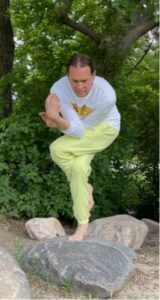TAI CHI YOGA PRINCIPLE # 8: Balancing , one of the 5 Types of Yoga Movements
My mother wanted me as a child to learn ballroom dancing. At the age of 11, I agreed. I signed sign up to make her happy since making my mother happy was more important than my own happiness.
As I went through the doors of the dance studio for the 1st lesson, my nerves were consuming my stomach. The teacher organized us into pairs. She demonstrated a few steps. The music started and my embarrassment ensued. I stepped on my poor partner’s feet so many times that she had to seek treatment. I chose to retire and retreat back to the farm.
Then there was my high school basketball career. I would like to brag that I was a big star, but I was not. After starting all four years, I barely made 2nd team all-conference. I was proficient at dribbling off my knee out of bounds, tripping as I made a quick move, and setting an all-time record for how many times I hit the floor in a game. I liked to say it was because of all those times I was diving for the ball, but when I did, I knew better. The truth was that I lacked coordination and balance.
Photo 2006 of John in Eagle Balance
Rather than confront my lack of coordination and balance, I worked around it. I survived in college basketball by working hard on defense, out-hustling those around me, passing instead of dribbling, and leaving the quick moves to those more gifted than me. I resigned myself to the belief that I was destined to pass through life awkward, clumsy, and unable to balance.
When I signed up for my first yoga class, I thought it was just about stretching and flexibility. No one told me that yoga (and later tai chi) were about balance. The yoga teacher did not introduce standing balances until the 3rd lesson. By that time, I loved yoga so much that I was prepared for the embarrassment of not being able to balance.
The instructor announced a new balance called the Eagle. Then she demonstrated it. She wrapped one leg around the other and then did the same with her arms. While balancing on the one leg, she lowered her bent knee until she looked like an eagle perched on a cliff. As smoothly as she had wrapped herself up in the balance, she slowly and gracefully unwrapped herself. Then came those dreaded words, “Now it’s your turn.”
Sure enough, I then proceeded to live up to my reputation in the childhood dance studio and on the high school basketball floor. As I tried to wrap one leg around the other, I FELL DOWN. I laid there for a minute, then got up, picked my pride off the floor, and tried again. This time I did not fall down, but I also could not stay balanced. My instructor gently chided me to keep breathing as I tried to balance and that as I did, it would someday help me achieve balance. That defied logic to me. Keep squeezing my stomach in and out while at the same time trying to balance?
That night’s fall was a turning point. I decided I was tired of my lack of coordination; of not being able to balance. I resolved that I would become graceful, smooth, and coordinated. I was going to balance on life’s rocks, wherever I found them.
While most of yoga had come relatively easy, balancing definitely did not. However, I listened to what my instructor kept saying, “Making sure you maintain your stomach breathing is more important than how well you balance; and that if – while trying to balance you can control your stomach squeezing in as you exhale and inflating out as you inhale, your balance will naturally come on its own”.
And she was right. In less than a month after I first fell down, one day I noticed how flawlessly I wrapped myself into the Eagle balance, held it for a number of deep breaths, and seamlessly unwrapped myself. I felt liberated. I was elated. One of life’s giant victories for me.
As with other weaknesses that I learned to turn into strengths, balancing eventually became a strength, especially as I began to learn tai chi. I found that Tai chi was continual one-legged, bent-knee balancing done rotating one side of the body slowly and rhythmically around the other. The slowness of tai chi made balancing even more challenging. I found that the more slowly I tried to lift, pivot, and flow, the more difficult its balancing was. As the years have passed by, the balancing of tai chi yoga has become unconscious, second nature, and as natural as breathing with my stomach.
Today, I love to balance. I love to be balanced and feel balanced. Balancing has become a state of mind as well as a condition of the body. BALANCING helps me to be more BALANCED. And that is one of the great joys of Tai Chi Yoga.
To be barefoot balancing on an uneven rock in the middle of a mountain stream and in a park? Sweet.
[FOOTNOTE: Excerpt from book “Power of Tai Chi Yoga . . .” by John C Neubauer published in 2009 and updated in 2021.]

